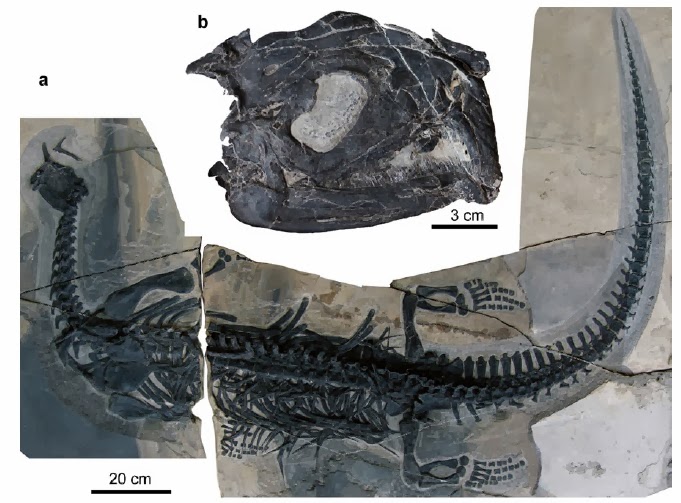 |
Fig. 3. Some teeth extracted from the excavation of Tam Hang south in 2003:
Bos cf. sauveli (a) left P3 (TH455), (b) left d4 (TH544); Panthera tigris ssp., (c) right p4 (TH133); Arctonyx collaris cf. rostratus, (d) right M1 (TH119), (e) right M1 (TH120); Sus scrofa, (f) left M3 (TH417); Sus cf. barbatus, (g) right M3 (TH414). |
Abstract
Tam Hang, located in northeastern Laos, in the Hua Pan province, is a reference site not only for its numerous archaeological and human remains, but also for its two faunal assemblages, whose composition suggests different dating in the Pleistocene. Discovered in 1934 by Jacques Fromaget, a new excavation of the site has been undertaken in 2003. During this campaign, at Tam Hang south, 575 isolated teeth of mammals were extracted from a deep layer of calcareous breccia. This assemblage corresponds to that one described by Arambourg and Fromaget [C. Arambourg, J. Fromaget, Le gisement quaternaire de Tam Nang (Chaîne Annamitique septentrionale). Sa stratigraphie et ses faunes, C. R. Acad. Sci. Paris 203 (1938) 793–795.], as characterized by the presence of Ursus premalayanus, and the rarity of Pongo pygmaeus. Systematics and analysis of teeth show that this new assemblage is composed of archaic subspecies, characteristic of the Middle Pleistocene. The faunal composition suggests ecological conditions also found in other Pleistocene sites of the South-East-Asia mainland area. Finally, the analysis of the process of preservation and deposition enables a brief description of the taphonomy specific of karstic systems.
Keywords: Tam Hang; Laos; Karstic system; Pleistocene; South-East Asia mainland
Table 1 List of teeth from Tam Hang south
defined at the specific level by Christelle Tougard (CT), Pierre-Olivier Antoine (POA)
and Anne-Marie Bacon (AMB)
 |
|
Anne-Marie Bacon, Fabrice Demeter, Christelle Tougard, John De Vos, Thongsa Sayavongkhamdy, Pierre-Olivier Antoine, Bounheuang Bouasisengpaseuth, Phonephanh Sichanthongtip. 2008. The Discovery of a Pleistocene Fauna in Karstic Fills at Tam Hang in Laos: Preliminary Results.
Comptes Rendus Palevol. 7(5); 277–288.
DOI:
dx.doi.org/10.1016/j.crpv.2008.03.009
ABSTRACT
Tam Hang, localisé dans le Nord-Est du Laos, dans la province de Hua Pan, est un site de référence, non seulement pour ses nombreux vestiges archéologiques et humains, mais aussi pour ses deux assemblages fauniques, dont le contenu suggère des âges différents dans le Pléistocène. Découvert en 1934 par Jacques Fromaget, son exploitation a été reprise en 2003. Lors de cette nouvelle campagne, nous avons extrait de l'épaisse couche de brèche calcaire qui affleurait massivement à Tam Hang sud, 575 dents isolées de mammifères. Cet assemblage correspond à celui qu'Arambourg et Fromaget [C. Arambourg, J. Fromaget, Le gisement quaternaire de Tam Nang (Chaîne Annamitique septentrionale). Sa stratigraphie et ses faunes, C. R. Acad. Sci. Paris 203 (1938) 793–795.] caractérisent par la présence d'Ursus premalayanus et par la rareté de Pongo pygmaeus. La détermination systématique et l'analyse des dents montrent que cet assemblage comprend plusieurs sous-espèces archaïques, typiques du Pléistocène moyen. La composition de la faune suggère des conditions écologiques que l'on retrouve également dans les autres sites pléistocènes d'Asie du Sud-Est continentale. Enfin, l'analyse des processus de conservation et de dépôt permet de rappeler brièvement quels sont les facteurs taphonomiques spécifiques des milieux karstiques.
Mots clés: Tam Hang; Laos; Milieu karstique; Pléistocène; Asie du Sud-Est continentale
Anne-Marie Bacon, Fabrice Demeter, Christelle Tougard, John De Vos, Thongsa Sayavongkhamdy, Pierre-Olivier Antoine, Bounheuang Bouasisengpaseuth, Phonephanh Sichanthongtip. 2008. Redécouverte d'une faune pléistocène dans les remplissages karstiques de Tam Hang au Laos : premiers résultats. Comptes Rendus Palevol. 7(5); 277–288. DOI: dx.doi.org/10.1016/j.crpv.2008.03.009













































